Patna Patchwork
The Bihar Museum Biennale showcases a confluence of international and local cultures
 Noor Anand Chawla
Noor Anand Chawla
 Noor Anand Chawla
Noor Anand Chawla
 |
25 Aug, 2023
|
25 Aug, 2023
/wp-content/uploads/2023/08/PatnaPatchwork1.jpg)
A floor ashtamangala from Nepal
THE STEREOTYPES associated with Patna and Bihar are, unfortunately, soaring crime rates and crumbling infrastructure. The better informed will point to its historic legacy, as a fount of spirituality (Lord Buddha’s enlightenment), place of learning (Nalanda University) and seat of mighty empires (Mauryas, Guptas, Palas, Surs, and Mughals). Yet, despite its glorious past, few would accord it cultural importance in a modern setting. Fortunately, led by the state-of-the-art Bihar Museum that opened its doors a few years ago, Patna is now asserting its cultural identity.
Housed in a modern building made on Japanese architectural principles, the museum is an island of culture and design in the heart of the city. Its vast and impressive permanent collection is displayed and stored using cutting-edge technology and is curated to mimic a compelling story through the ages. But where most museums would call it a day having achieved this much, Bihar Museum has made it a point to connect with its audience by being dynamic with its offerings.
This is the spirit in which the Bihar Museum Biennale was instituted in 2021 as a bi-annual cultural event that celebrates museums for one of the first times in the world by bringing together multiple Indian and international museum professionals, artists and art lovers under its roof. Kicking off its second edition recently on the Museum’s Foundation Day, the biennale will run till December 31. In these five months, it will showcase several rolling exhibits varying from two weeks to several months.
“The idea was to never keep it static,” says Anjani Kumar Singh, director general of the museum and advisor to the chief minister, Bihar. “We realised that just having an excellent collection isn’t enough for people to keep returning to the museum. We have to keep organising activities to keep them interested. In fact, now our collection has become supplementary as our rotating activities have gained more importance. The Bihar Museum Biennale allows us to view our museum as a dynamic laboratory of ideas, fostering the generation of knowledge systems and facilitating cultural dialogues between objects and viewers. This unique platform serves as an avenue for sharing histories and strategies,” he adds.
The brainchild of Chief Minister Nitish Kumar, the museum was started with the motive of reinventing Patna’s image by restoring its status as a cultural icon, through an experiential and interactive museum. Singh was appointed to helm the project, and he is aided in this task by Alka Pande, chief curator and artistic producer of the biennale. Following the brief that a museum must be more than a repository of antiquities offering little engagement, they put together a long list of exhibits and programmes with the hope of offering an unsurpassed visitor experience.
Pande explains, “There are multiple biennales on art but nowhere in the world do people interrogate museums. Bihar has always been a forerunner, so this biennale centred on a museum which is the first of its kind, makes sense. Museums speak of the unbroken thread of a civilisation’s memory, creating a space where profound ideas thrive. The Bihar Museum Biennale stands as a remarkable example of this phenomenon, as it not only showcases beauty but also represents the diverse and pluralistic culture of India.”
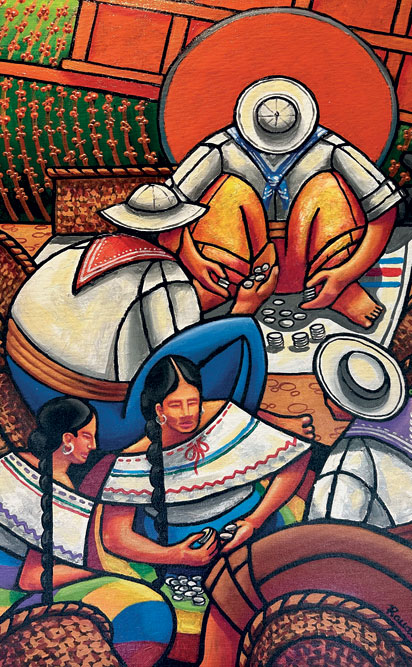
The opening exhibits at the biennale include cross collaborations with other Indian museums, who have loaned their works for the entire duration of the show. Kiran Nadar Museum of Art (KNMA) from Delhi was brought on board as a knowledge partner for the biennale, to design an outreach plan for the museum to be more interactive and engaging for the public. Additionally, two large-scale works from their collection — by Sudarshan Shetty (Taj Mahal) and Subodh Gupta (Cheap Rice) — enjoy pride of place at the entrance of the museum. The Salar Jung Museum, Hyderabad has displayed many contemporary art works from its collection highlighting the artistic aspect of Telangana’s culture. These include Kandi Narsimlu’s rustic village scenes, and Kavita Deuskar’s engaging human figures, among others. The Chhatrapati Shivaji Maharaj Vastu Sangrahalaya (CSMVS) from Mumbai has shared Three Dimensions of Divinity — Thanjavur Art Revealed, which tells of the interconnected aspects of faith, the artists who have shaped it, and the patrons who have supported it.
Other participants of the biennale include independent artists, and countries like Nepal, Israel, Costa Rica and others. Italian artist Tarshito will display his work titled Continuum: Vision of India, as will artist Brahmdeo Ram Pandit in an exhibit called From Clay to Beauty: Terracotta Art and Udayraj Gadnis whose Suryakal will consist of paintings of the sun and photographs of Chhath Puja in Bihar.
Country exhibits include one from Costa Rica–Panama titled Songs of the Earth, which seeks to highlight the lush rainforests, agricultural economies, and indigenous heritage of these nations through art. The collections consist of pieces of Chorotega pottery, a painting by artist Raudyn Alfaro Araya and appliqued works of indigenous Mola textiles. Russia’s display, Mystic Universe 360, uses a 360-degree digital dome to show films imparting the message of Vedic cosmology. In keeping with its interactive nature, the dome is placed next to the popular children’s gallery of the Bihar Museum.
Nepal: Where the Gods Reside, curated by the Nepal Art Council, is the largest of the country-specific offerings and will be on display till September 7. Through 76 paintings, sculptures, and metal statues made using lost wax and repousse techniques, filigreed work with semi-precious stone inlay, ceramics and a massive floor mandala made with sediment, it seeks to show Nepal’s rich spiritual and philosophical traditions.
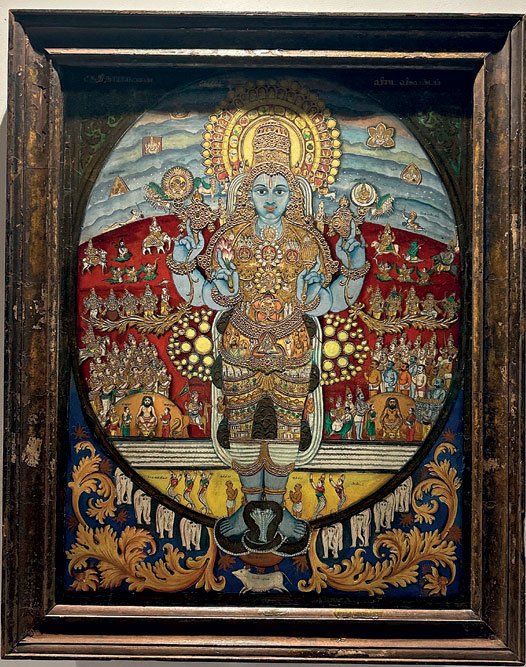
As an ode to India’s G-20 presidency this year, opening simultaneously with this edition of the biennale is the G20: Together We Art. Also curated by Pande, it brings together the work of 19 artists from G-20 member countries and nine guest countries, as well as 20 works by Indian artists across disciplines. Following the theme of Vasudhaiva Kutumbakam or “the world is a family”, a concept embedded in the Maha Upanishad, the exhibit gives a platform to artists responding to universal concerns through their work.
Climate change is a common theme, of which a standout work has been made by artist Chandra Bhattacharjee from his Veins of the Earth series. In this acrylic painting awash in hues of muted rusts and oranges, one sees his conscious move away from his previous work centred on human figures, to one where he depicts scenes of nature to highlight human destruction of the natural world. Similarly, Italian artist Francesca Leone, through her large installation of sheet metal roses titled Una Rosa, è Una Rosa, è Una Rosa (A rose is a rose is a rose), likens the lacerations on her roses to human scars, speaking of the natural beauty that is being destroyed by humans.
The growing scourge of digitalisation is aptly captured in works of artists like Sara Sejin Chang from the Netherlands through her kitschy installation, The A-Symmetrical Imperialistic Data Server, which draws attention to the negative impact of the extraction of energy and resources from impoverished areas by imperialism. There is also Thijs Biersteker from the UK, whose work Econario questions the impact that today’s digital choices will have on the state of nature over the next 30 years. Here a robotic plant moves like a fragile seedling driven by changes in the Biodiversity Intactness Index, which measures how much of a region’s natural biodiversity still exists.
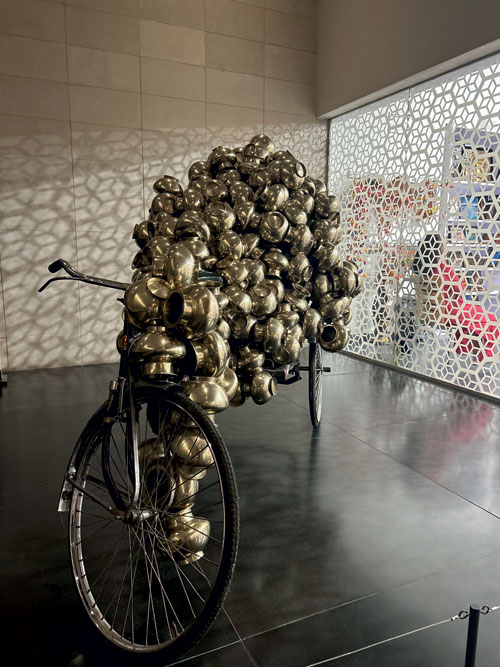
Gender inclusivity is explored in the photographic work of Thalente Khomo from South Africa, whose compelling image of a girl child shrouded in a blue cloth invokes both nostalgia and trauma. Global oneness is embodied in the digital photographs of American artists Hank Willis Thomas and Emily Shur in collaboration with Eric Gottesman and Wyatt Gallery of ‘For Freedoms’, where the four essential human freedoms as proposed by President Franklin D Roosevelt in 1941 are explored in the context of contemporary American identities. This theme is also visible in Ayesha Seth Sen’s mixed media dome Vasudhaiva Kutumbakam, which points to the interconnectedness of the world and the shared responsibility of humanity to protect and nurture the planet we inhabit.
Ther striking works include Sanatan Dinda’s Bodhi Tree made of e-waste, which questions the impact of discarded electronics on the environment and society; GR Iranna’s terracotta-textured work Dhul (Dust to Dust) which according to him, “embodies the form of everything”; Seema Kohli’s detailed painting Heartbeat of Universe, Quicksand’s Glitter, which symbolises the emergence of everything from darkness; Sanjay Kumar’s faceless Statue of Peace covered in religious symbols representing a voluntary surrender of atrocities committed against humanity; and the Mauritian installation made with Spanish moss and collected coloured plastic by artist Dharmadeo Nirmal Hurry, which emphasises the negative space that exists between nature and man-made objects.
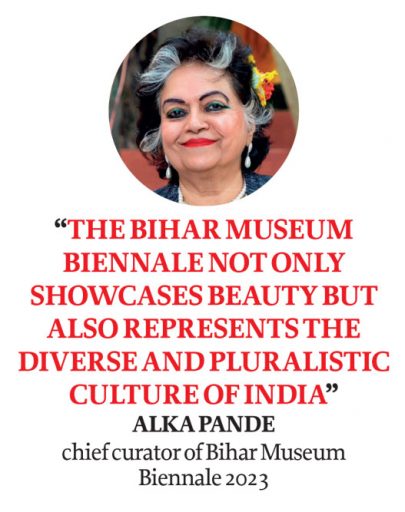
There are two smaller but noteworthy exhibits that have been included in the purview of the biennale as well. The first of these is Tracing Tradition: Padmashri Folk Artists of Bihar where one can peruse stellar folk art across local artistic traditions like Manjusha art (eight-pillared temple-shaped boxes made with paper, jute and bamboo), Madhubani paintings made from the paste of powdered rice, Tikuli art made with bindis or dots, appliqué embroidered work and others. Second is, Patna: City of Museums, which traces the rich cultural history of the city through its many museums, starting with the Patna Museum established in 1917 by the British, and culminating in the Bihar Museum. Through its widespread collection of treasured antiquities like the beautiful Didarganj Yakshi dating back to the 3rd century BCE, as well as contemporary folk art from Bihar, this museum is changing the traditional understanding of the role of a museum in India.
“We believe that it’s important to take inspiration from the past but create something for the future. That was our inspiration behind both the Bihar Museum and the museum biennale concept. We were also keen to create an international level institution as India lacks the kind of infrastructure that attracts international exhibits. In the process of filling that gap through the museum, we became a cultural centre. The Bihar Museum serves as a fitting testament to the enduring legacy of our land by showcasing the creative genius that has blossomed in Bihar over the centuries,” says Anjani Singh. n
(The Bihar Museum Biennale 2023 will run at the Bihar Museum, Patna till December 31, 2023)
About The Author
MOst Popular
3

/wp-content/uploads/2025/07/Cover_Crashcause.jpg)



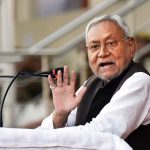
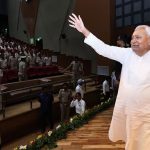


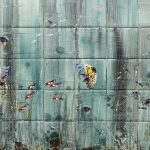
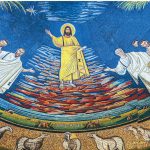

More Columns
Bihar: On the Road to Progress Open Avenues
The Bihar Model: Balancing Governance, Growth and Inclusion Open Avenues
Caution: Contents May Be Delicious V Shoba